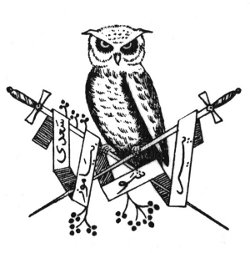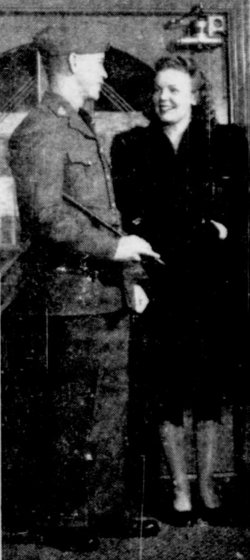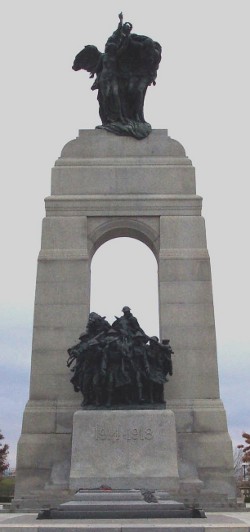Combat Arms School Graduation Address 1976
Topic: Officers

Image from the magazine of the Canadian Armed Forces: Sentinel, Vol. 6, No. 2, February, 1970.
Graduating Ceremony
Combat Arms School August 1976
Address By Major General Bruce F. Macdonald, DSO, CD
Colonel Commandant RCAC
At Graduating Ceremony, Combat Arms School August 1976
Armour Newsletter, No 7, January 1977
 Your Honour, (The Lieutenant Governor), General McGregor, Colonel Nicholson, Distinguished Guests, Visitors, Officer Candidates, Ladies and Gentlemen.
Your Honour, (The Lieutenant Governor), General McGregor, Colonel Nicholson, Distinguished Guests, Visitors, Officer Candidates, Ladies and Gentlemen.
You young gentlemen by your presence and your performance here today do credit and honour to Canada, to the Armed Forces and to yourselves. I congratulate you.
I am sure your training program has been vigorous and difficult. Indeed I hope this is the case for you are all embarked on a difficult, hazardous and demanding profession. Those who aspire to lead Canadians in combat must be stressed and tested in their training. If the training is easy then it is not good.
You are fortunate to be getting your training here. This Combat Arms School is unique. For here you train as you will fight — not as Infantry, Armour or Artillery but as members of the ground team of combined arms.
Let me, for a moment, address myself to those of you who will join the Regular Forces:
a. You have not chosen an easy profession.
b. Your effectiveness rests on three bases, namely moral, mental, and physical fitness. Guard them well.
c. You walk in the steps of some giants of history; men of the category of Wavell, Eisenhower, Marshall and Montgomery.
d. Indeed, in a Canadian context we are all honoured today to have here with us General Jean Victor Allard. It might interest you to know that General Allard started his military career as a Second Lieutenant in the Three Rivers Regiment. Following a most distinguished wartime career he remained in the Regular Forces and became Chief of the Defence Staff.
If you are going to be professional soldiers you should expect to face some criticism and misunderstanding. Let me suggest what some of the charges may be and what your reply might be:
a. People may charge that you, as a soldier, like war. This is like suggesting that the doctor who spends his life in the study and cure of cancer likes cancer.
b. Some people may comment upon the futility of armed forces and allege that they contribute to the danger of war. May I suggest that you quote to them the following maxim "Love without power exposes the world to the frightening hazards of power without love".
c. Thirdly, people may comment on how expensive the military are. I urge you to ask how expensive is unpreparedness? I think the record of history is entirely clear. It indicates that had the Allies been prepared to fight in 1914 or 1939 both of these wars could have been avoided — at a vast saving in lives and treasure.
d. Last Spring I heard an address by Dr. Luns, the Secretary General of NATO. He made the point that the greatest act of provocation is to be unprepared for war. This is a very great truth. It should be remembered by all.
Finally, I wish to address a few words to those of you who upon graduation are proposing to enter Canada's militia:
a. You also have chosen a challenging avocation.
b. You are citizen soldiers who walk hand in hand with your Regular Force colleagues who are the soldier citizens.
c. Your greatest enemies are frustration and public apathy. Remember that all the problems you confront have been experienced before. They happened in the days before 1914 and again in the days before 1939.
You who choose to serve in Canada's Reserve Forces are the present day embodiment of some one and one quarter million Canadians, living and dead, who proudly wore the uniform of the Armed Forces of Canada in World War II. You can serve proudly for you fill a great and fundamental need; though at any point in history this may not be recognized by some.
God forbid that there should be either war or revolution but the lesson of history is terribly clear. Heretofore there has always been war and revolution; there is nothing to suggest that the nature of man has changed.
In closing let me offer you this final thought. Sometimes it is suggested that Canada does not need armed forces in peacetime because if war comes we will be able to find the necessary experts. It is true that we can recruit doctors, engineers and the logisticians from civilian life. However, what is not understood is that we cannot find and we cannot hire from any civilian profession men who are skilled in the art of leading and training men for war. This is the special expertise possessed only by those of you who are trained in the art of military leadership. Men like you cannot be hired, they must be grown and educated in Canada, in peacetime.
Yours is an honourable profession that bears great responsibility. You must be proud of your task, you must be worthy of your great responsibility. I salute you for what you have done, for what you are doing and for what you will do.
Good fortune to all of you.

Posted by regimentalrogue
at 12:01 AM EDT








 But for every man lost [at
But for every man lost [at 






 1. Soldiers fight only enemy combatants.
1. Soldiers fight only enemy combatants.


 … The capital of
… The capital of  The thousands of young soldiers in the
The thousands of young soldiers in the 
 Down the street from Parliament Hill, at the centre of
Down the street from Parliament Hill, at the centre of 

 "I am going to relate to you something that happened to me which I think highlights this business. In my parachute battalion we had a Corporal Sheriff. He was a good corporal but he had his share of rockets and so on. He didn't make sergeant when there was plenty of promotion flying about but he was a good battalion and a good company man. He joined us in 41, fought with us in North Africa, Sicily and Italy and finally at Arnhem, and it was at Arnhem that he was wounded. We had been in the prison camp for I should think about three months with no knowledge of him at all when I was told that he was in the reception hut, and so I scrounged a few cigarettes which were available, because I was told he was in bad shape, and went up to the hut.
"I am going to relate to you something that happened to me which I think highlights this business. In my parachute battalion we had a Corporal Sheriff. He was a good corporal but he had his share of rockets and so on. He didn't make sergeant when there was plenty of promotion flying about but he was a good battalion and a good company man. He joined us in 41, fought with us in North Africa, Sicily and Italy and finally at Arnhem, and it was at Arnhem that he was wounded. We had been in the prison camp for I should think about three months with no knowledge of him at all when I was told that he was in the reception hut, and so I scrounged a few cigarettes which were available, because I was told he was in bad shape, and went up to the hut.

 … I was a Captain commanding the Supply Details. We had a Horse Transport Company. We had harness. The troops were trained to take the harness apart, put it back together, and hang it up in the Quartermaster's Stores. That is about as far as it went. We never did have a horse. We never did have a waggon.
… I was a Captain commanding the Supply Details. We had a Horse Transport Company. We had harness. The troops were trained to take the harness apart, put it back together, and hang it up in the Quartermaster's Stores. That is about as far as it went. We never did have a horse. We never did have a waggon.

 Your Honour, (
Your Honour, (



 TOW missile being fired by the Armoured Defence Platoon of the 2nd Battalion, Princess Patricia's Canadian Light Infantry at CFB Shilo. Photo by Mr. Doug Devin. From the back cover of the Canadian Armed Forces Sentinel magazine 1977, Vol. 13, Number 2.
TOW missile being fired by the Armoured Defence Platoon of the 2nd Battalion, Princess Patricia's Canadian Light Infantry at CFB Shilo. Photo by Mr. Doug Devin. From the back cover of the Canadian Armed Forces Sentinel magazine 1977, Vol. 13, Number 2.

